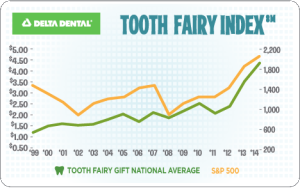Delta Dental has published the results of a new survey to raise awareness about the importance of oral health in children. The survey indicates relatively poor oral care behavior in under 12-year-olds that contributes to many American children having cavities
 According to Delta Dental, only 28 percent of U.S. parents would give their children an A grade
According to Delta Dental, only 28 percent of U.S. parents would give their children an A grade Although it is recommended that children brush and see a dentist as soon as the first tooth erupts, 63 percent of the parents interviewed stated that they began brushing once there were a few teeth or even a full set of teeth. In addition, 46 percent of parents with children under the age of 3 said that they put their child to bed with a bottle or sippy cup containing milk or juice, two beverages containing considerable amounts of sugar, at least once a week.
These figures suggest that parents may be contributing to their children's poor oral health condition, which could cause serious dental diseases, such as tooth decay. According to the Centers for Disease Control and Prevention, it is the most common chronic disease of children aged 6–11 in the U.S.
The 2015 Delta Dental Children's Oral Health Survey was conducted by Kelton, a global insights firm. Interviews were conducted nationally via e-mail with 1,325 parents of children up to age 12 from December 2014 to January 2015.
National Children's Dental Health Month is celebrated each February. It is sponsored by the American Dental Association and aims to educate adults and children on good oral hygiene
for oral health. About 86 percent stated that their children's oral health status is not as good as it could be. Although over 50 percent of the participants said that they think that oral care habits―rather than genetics or diet―contribute most to oral health, over 30 percent of the children did not brush twice a day and over 60 percent did not floss on a daily basis.
How would you grade your kids? Comment Below!
Reposted from: http://www.dental-tribune.com/articles/news/americas/22001_survey_reveals_poor_oral_hygiene_habits_in_us_children.html




